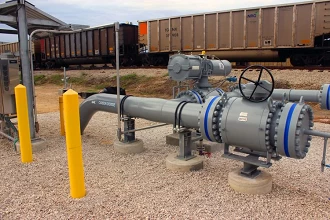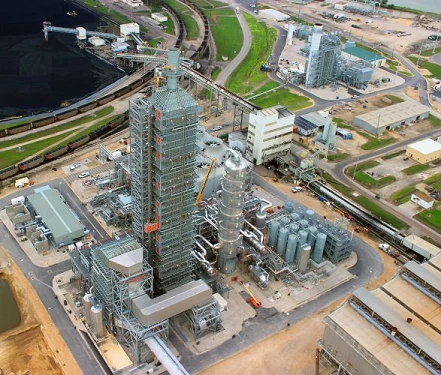CO2 Captured from a Coal Power Station Aids Oil Recovery
When coal is burned, carbon is almost all of what produces the energy. Burn carbon and heat and carbon dioxide (CO2) result.
Since the beginning of 2017, an ambitious carbon capture project at the W.A. Parish power plant near Houston has prevented 5,500 tons (5,000 metric tons) per day of CO2 emissions from entering the atmosphere—the equivalent of CO2 emissions from 350,000 cars. This project is Petra Nova, a joint venture of NRG Energy and JX Nippon, a global oil and gas company.
The plan was to install post-combustion carbon capture technology, provide the captured CO2 to an oil field for enhanced oil recovery, and use the increased oil production to pay for the Petra Nova project.
Petra Nova formed a joint venture with Hilcorp Energy, the owner of West Ranch oil field, a mature oil field about 80 miles away that could increase its production using enhanced oil recovery.

Pipe carrying supercritical carbon dioxide goes into the ground, headed for the West Ranch oil field 80 miles away. (Photo courtesy of NRG Energy)
TAKING THE CO2 OUT OF FLUE GAS
The Petra Nova project is designed to remove CO2 from the flue gas produced by 240 megawatts (MW) of coal-fired power generation from Unit 8 at the W.A. Parish generating station. Unit 8 is capable of producing about 610 MW, so the carbon capture process treats about 40% of the emissions from Unit 8. The total output of the W.A. Parish plant is over 3 gigawatts.
Flue gas from Unit 8 first goes into a quencher to cool it. Sulfur dioxide, which would interfere with CO2 capture, is removed by desulfurization processes. The cooled flue gas flows into the absorption tower. Inside this 300-foot structure, the flue gas goes up while an amine solvent “rains down,” said David Knox, senior director, external communications at NRG Energy. This captures about 90% of the CO2 contained in the flue gas.
The solvent is then heated and goes to the regenerator tower, where it releases the CO2. From there, the CO2 is dried and sent to the installation’s 27,000 hp (about 20,000 kW) compressor, one of the largest in the world, according to Knox.
Upon compression to 1700 to 1900 psi (117 to 131 bar) and cooling to about 100⁰F (38⁰C), the CO2, originally in a gaseous state, changes to a supercritical state that is neither liquid nor gas, but has some characteristics of both. Its density is like that of a liquid, while its viscosity is more like a gas. A material at temperature and pressure above its critical point behaves this way. The critical point for CO2 is 89.8⁰F (32.1⁰C) and 1070 psi (73.8 bar).
“It becomes a liquid, basically,” Knox said, “and is pumped to the oil field 82 miles away.” No pumps or added pressure are needed along the pipeline, he added, and the head loss over the 82 miles is about 200 psi (14 bar).
When asked about any special considerations in piping or valves in the process, Knox said stainless steel or other corrosion resistant materials are required for the flue gas and anywhere CO2 is in the presence of water. Downstream of the CO2 drying process, the flow components are carbon steel, he said.
NEW LIFE TO AN OLDER OIL FIELD
CO2 insertion has been used for many years as a means for enhanced oil recovery in mature oil fields where production has dropped over time, according to a National Energy Technology Laboratory publication.
CO2 pumped underground dissolves in the crude oil, making the oil less dense and less viscous. This allows some previously inaccessible oil to reach the well, increasing production. In the case of the Petra Nova project, CO2extracted at the coal plant is piped to the West Ranch oil field. There, it is inserted deep into the ground. This makes more oil available; in the first year of CO2 enhanced oil recovery, the output went from 300 barrels per day to 4000 barrels, according to an NRG case study of the project. The potential of the field is estimated at 60 million recoverable barrels using this enhanced method, with daily production reaching 15,000 barrels per day, according to a Department of Energy press release.
As it turns out, this insertion process also causes some of the CO2 to be stored in the oil field’s rock formation. Of all the CO2 inserted into the ground, about 20% remains behind within the rock.
When the oil and CO2 come to the surface, the CO2 is captured and reused, along with new CO2 coming from the coal plant.
To verify that the CO2 is staying in the ground and not going into the atmosphere, Petra Nova monitors the equipment, monitoring wells, and the air in the area. In addition, an independent service from the Bureau of Economic Geology at the University of Texas at Austin also monitors CO2 levels.
FINANCING AND BUILDING PETRA NOVA
Removing CO2 produced by burning fossil fuels is an expensive proposition, both in the equipment required and the energy and chemicals needed to capture CO2 from the flue gas.
The total Petra Nova project construction cost was about $1 billion. Financing was provided by a grant from the U.S. Department of Energy Clean Coal Power Initiative Program ($190 million), a $250 million investment from Japanese banks and $300 million in equity contributions from both NRG and partner JX Nippon.
On the revenue side, as joint owner of the West Ranch oil field, Petra Nova receives revenue from half the oil produced.
Construction began in July 2014 and was completed the end of 2016, on time and on budget.

The Petra Nova carbon dioxide extraction facility. The taller structure is the absorption tower. The smaller tower contains the regeneration process. (Photo courtesy of NRG Energy)
FUTURE CARBON CAPTURE
“While the technology is sound, the current application of CCUS [carbon capture, utilization and storage] in any commercial environment is limited,” said Todd Williams, partner, and Jonathan Aronoff, senior associate of ScottMadden, Inc., a North American management consulting firm specializing in energy. Williams and Aronoff offered their comments in an email interview.
“Currently the best business case is found in enhanced oil recovery” similar to the Petra Nova project, they said. Without a market to pay for the captured carbon dioxide to offset the construction and operating expenses, such projects are currently cost prohibitive, they added.
New federal tax credits are in place that can help such projects. However, carbon capture projects are likely to remain economically unfeasible in most situations without more changes, Williams and Aronoff said. Improved technology could drive down implementation costs. Increased financial incentives for reducing carbon emissions would improve the economics. New markets for CO2 other than enhanced oil recovery could provide needed funding in geographic areas far from oil fields.
 +86 512 68781993
+86 512 68781993 


















